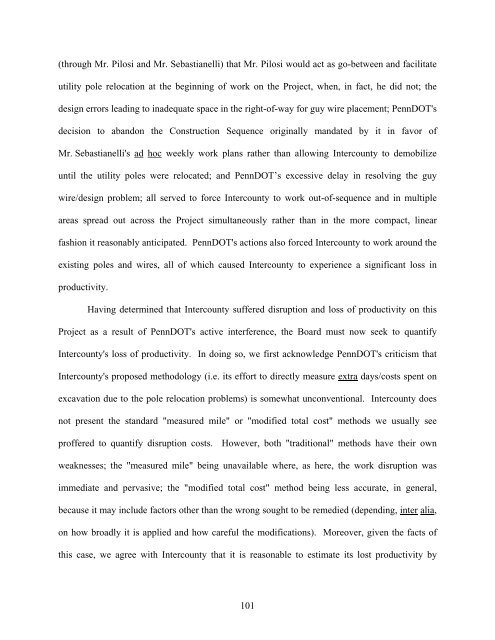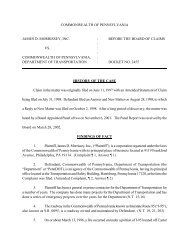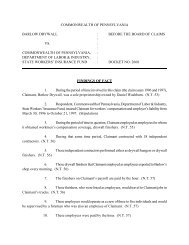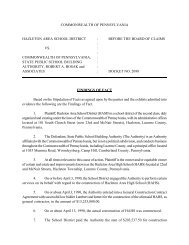3720 - Board of Claims
3720 - Board of Claims
3720 - Board of Claims
Create successful ePaper yourself
Turn your PDF publications into a flip-book with our unique Google optimized e-Paper software.
(through Mr. Pilosi and Mr. Sebastianelli) that Mr. Pilosi would act as go-between and facilitate<br />
utility pole relocation at the beginning <strong>of</strong> work on the Project, when, in fact, he did not; the<br />
design errors leading to inadequate space in the right-<strong>of</strong>-way for guy wire placement; PennDOT's<br />
decision to abandon the Construction Sequence originally mandated by it in favor <strong>of</strong><br />
Mr. Sebastianelli's ad hoc weekly work plans rather than allowing Intercounty to demobilize<br />
until the utility poles were relocated; and PennDOT’s excessive delay in resolving the guy<br />
wire/design problem; all served to force Intercounty to work out-<strong>of</strong>-sequence and in multiple<br />
areas spread out across the Project simultaneously rather than in the more compact, linear<br />
fashion it reasonably anticipated. PennDOT's actions also forced Intercounty to work around the<br />
existing poles and wires, all <strong>of</strong> which caused Intercounty to experience a significant loss in<br />
productivity.<br />
Having determined that Intercounty suffered disruption and loss <strong>of</strong> productivity on this<br />
Project as a result <strong>of</strong> PennDOT's active interference, the <strong>Board</strong> must now seek to quantify<br />
Intercounty's loss <strong>of</strong> productivity. In doing so, we first acknowledge PennDOT's criticism that<br />
Intercounty's proposed methodology (i.e. its effort to directly measure extra days/costs spent on<br />
excavation due to the pole relocation problems) is somewhat unconventional. Intercounty does<br />
not present the standard "measured mile" or "modified total cost" methods we usually see<br />
pr<strong>of</strong>fered to quantify disruption costs. However, both "traditional" methods have their own<br />
weaknesses; the "measured mile" being unavailable where, as here, the work disruption was<br />
immediate and pervasive; the "modified total cost" method being less accurate, in general,<br />
because it may include factors other than the wrong sought to be remedied (depending, inter alia,<br />
on how broadly it is applied and how careful the modifications). Moreover, given the facts <strong>of</strong><br />
this case, we agree with Intercounty that it is reasonable to estimate its lost productivity by<br />
101






